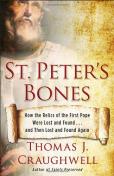BKMT READING GUIDES
St. Peter's Bones: How the Relics of the First Pope Were Lost and Found . . . and Then Lost and Found Again
by Thomas J. Craughwell
Paperback : 144 pages
1 club reading this now
0 members have read this book
In 1448 a team of architects and ...
Introduction
In this fascinating account of the search for the remains of the world's first pope, none other than Peter, the chief apostle of Jesus, Thomas J. Craughwell takes us on one of the most exciting archaeological finds of the twentieth century.
In 1448 a team of architects and engineers brought Pope Nicholas V unhappy news: the 1,100-year-old Basilica of St. Peter suffered from so many structural defects that it was beyond repair. The only solution was to pull down the old church--one of the most venerable churches in all of Christiandom--and erect a new basilica on the site. Incredibly, one of the tombs the builders paved over was the resting place of St. Peter.
Then in 1939, while reconstructing the grottoes below St. Peter's Basilica, a workman's shovel struck not dirt or rock but open air. After inspecting what could be seen through the hole they'd made in the mausoleum's roof, Pope Pius XII secretly authorized a full-scale excavation. What lay beneath? The answer and the adventure await. In this riveting history, facts, traditions, and faith collide to reveal the investigation, betrayals, and mystery behind St. Peter's burial place.
Editorial Review
Q&A with Thomas J. Craughwell
Q. Youâ??ve written a couple books on saints and one on relics. What is it that first drew you to this topic?
A. Iâ??ve been studying and publishing about the saints for thirty years. Naturally, if you study the saints, relics will be part of the picture.
Q. What inspired you to write St. Peterâ??s Bones?
A. I became especially interested in the story of the rediscovery of St. Peterâ??s relics after a 2006 visit to Rome, when I toured the Scavi, the excavations below St. Peterâ??s Basilica where the tomb of St. Peter is located. Through a glass door, I could see his bones. It was an unforgettable experience and led me to write this book.
Q. What do you hope readers will take away from St. Peterâ??s Bones?
A. I hope they find, as I did, that this is an Indiana Jones story, a quest for something priceless that was lost and then found.
Q. How did you go about researching this subject?
A. Several of the archaeologists involved in the excavation published accounts of their finds, and fortunately Fairfield University library (about 30 minutes from my house) had English translations of these books. Margherita Guarducci, the specialist in ancient inscriptions, also wrote about her findings, and her book is available online.
Q. Did you discover anything that was particularly surprising?
A. It was interesting to learn that were tensions among the archaeologists, and ever greater tension between the archaeologists and Msgr. Ludwig Kaas, the administrator of St. Peterâ??s Basilica. You would think they would all work together like a well-oiled machine, but human foibles emerged even among people who were at the top of their field and involved in one of the most significant archaeological digs in history.
Discussion Questions
No discussion questions at this time.Book Club Recommendations
Recommended to book clubs by 0 of 0 members.
Book Club HQ to over 90,000+ book clubs and ready to welcome yours.
Get free weekly updates on top club picks, book giveaways, author events and more








